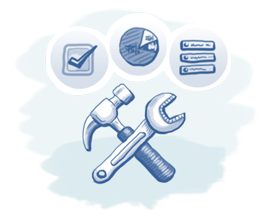 Sales performance management is anything but easy—just ask anyone who has done it.
Sales performance management is anything but easy—just ask anyone who has done it.
The sales manager is supervising people who are innately self-sufficient loners and who really don’t want to be supervised. Salespeople make their own observations and conclusions and commonly don’t take directions too well. Add to all of that the lack of accurate analysis tools on the part of sales management and you have a recipe for uncertainty at best.
But there are 4 steps which, if fully applied, will at the least greatly ease sales performance management’s burden:
#1: Use a standardized but flexible sales process.
While you may quite frequently hear the advice “use a sales process,” there are sales processes and then there are sales processes. When a sales process is not well thought out, carelessly slapped together and more or less forced on salespeople, it won’t assist sales reps in selling nor assist sales managers in managing. Both salespeople and sales manager must find their own ways around it in order to actually accomplish sales.
There is actually a process to establishing a sales process. It consists of isolating the most successful methods of selling your product or service, methods used by your best reps. The sales process is then laid out and tested, and feedback utilized to streamline it.
The best sales processes are never set in stone. They are as dynamic as the market in which they exist. When it is found that a step is unnecessary or incomplete or missing, the situation can be quickly rectified.
A company that is sharp enough to establish a sales process in this manner must also be sharp enough to only utilize a CRM solution that can be rapidly adapted to their sales process.
Once a sales process is fully established, the necessary metrics must be defined and implemented so that the various phases of the sales process are accurately measured.
#2: Have accurate analytics and know how to use them.
A wise sales consultant once said that a sale manager must “lead not lag.” This means the sales manager is utilizing accurate sales analytics to forecast and guide the sales force—not waiting for the quota to be met or not met.
Not only does lack of proper metrics make it difficult for a sales manager to make decisions or take action—especially over a long distance—it also increases the likelihood of the sales manager making the wrong calls in management decisions. In the absence of correct information one makes assumptions which can often be incorrect. Acted upon these assumptions can only harm a sales force and therefore reduce sales.
Precise metrics that take each step of a sales process into account must exist. Beyond mere existence such metrics must also be understood. For example a sales manager could be comparing one rep’s performance to another’s and finding the first salesperson to be underperforming. But comparing that first rep’s performance against the average might show that both of them are above that average, so that first rep is actually doing well. Or utilizing another metric such as “size of average deal” it is discovered that the first rep actually has deals well above the sales force average size, and there are just fewer of them. He or she is obviously doing something right—they just need more leads or more help.
Of course the CRM solution chosen must have the capability for the company to rapidly establish and use the right sales analytics.
The proper analytics lead to the next step.
#3: Be able to accurately forecast.
Sales forecasting has traditionally been conducted by consultation with sales reps and utilizing their “best guesses” as to when sales would close and for how much. Such guesswork might have been cloaked in fancy spreadsheets and presentations—but it was still guesswork.
Sales forecasts affect every level of the company and its future. Making them accurate not only gives the sales manager far better control (not to mention repute) it brings a stability, confidence and success to the entire company heretofore unseen.
The CRM solution must also posses the capability to turn accurate analytics rapidly into forecasts.
Where does this all lead?
4#: Use all these tools to fully manage your opportunities.
At the end of the day these tools and methods all add up to one thing: opportunity management. By utilizing a CRM solution through which you can view the individual steps of your sales pipeline, successful methods (beyond those of the sales process steps themselves) can be isolated and exploited. Different types of leads can be closely examined as to their viability and quality; the good ones can be harnessed and more of them obtained.
How does all of this affect sales management? Sales managers can now keep reps fully on track with opportunities that are truly worthwhile, and acquire more of them. When salespeople don’t have enough qualified leads or potential sales, they tend to cling to every opportunity they can get their hands on including marginal ones, leading to potential losses. With plentiful viable opportunities they can only flourish.
Utilize these 4 simple steps to easier sales performance management—and bring about a stable rise in your sales.
See our other articles on sales analytics and sales management.










